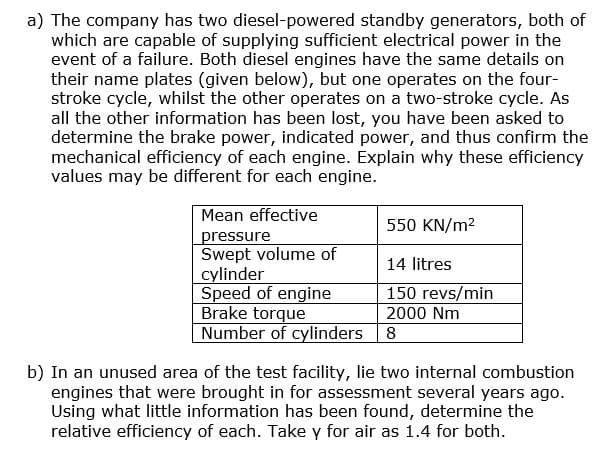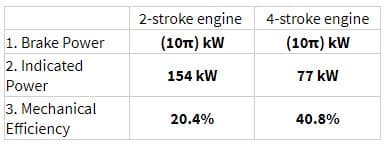) In an unused area of the test facility, lie two internal combustion engines that were brought in for assessment several years ago. Using what little information has been found, determine the relative efficiency of each. Take y for air as 1.4 for both.
) In an unused area of the test facility, lie two internal combustion engines that were brought in for assessment several years ago. Using what little information has been found, determine the relative efficiency of each. Take y for air as 1.4 for both.
Elements Of Electromagnetics
7th Edition
ISBN:9780190698614
Author:Sadiku, Matthew N. O.
Publisher:Sadiku, Matthew N. O.
ChapterMA: Math Assessment
Section: Chapter Questions
Problem 1.1MA
Related questions
Question
100%
Hello, so i have attached two images. the first image is the quetions, i need part b) answered if possible. i have attached my findings to part a) to add to the little information we know to help with part b if needed. Thnks

Transcribed Image Text:a) The company has two diesel-powered standby generators, both of
which are capable of supplying sufficient electrical power in the
event of a failure. Both diesel engines have the same details on
their name plates (given below), but one operates on the four-
stroke cycle, whilst the other operates on a two-stroke cycle. As
all the other information has been lost, you have been asked to
determine the brake power, indicated power, and thus confirm the
mechanical efficiency of each engine. Explain why these efficiency
values may be different for each engine.
Mean effective
550 KN/m²
pressure
Swept volume of
14 litres
cylinder
Speed of engine
150 revs/min
Brake torque
2000 Nm
Number of cylinders | 8
b) In an unused area of the test facility, lie two internal combustion
engines that were brought in for assessment several years ago.
Using what little information has been found, determine the
relative efficiency of each. Take y for air as 1.4 for both.

Transcribed Image Text:1. Brake Power
2. Indicated
Power
3. Mechanical
Efficiency
2-stroke engine
(10π) KW
154 kW
20.4%
4-stroke engine
(10) KW
77 kW
40.8%
Expert Solution
This question has been solved!
Explore an expertly crafted, step-by-step solution for a thorough understanding of key concepts.
Step by step
Solved in 3 steps with 2 images

Follow-up Questions
Read through expert solutions to related follow-up questions below.
Follow-up Question
The p-v diagram all make sense, but the equations are unreadable. i dont understand where some units have come from etc, could you please further explain the equations. thnks, feel free to take the relevant amount of credits
Solution
Knowledge Booster
Learn more about
Need a deep-dive on the concept behind this application? Look no further. Learn more about this topic, mechanical-engineering and related others by exploring similar questions and additional content below.Recommended textbooks for you

Elements Of Electromagnetics
Mechanical Engineering
ISBN:
9780190698614
Author:
Sadiku, Matthew N. O.
Publisher:
Oxford University Press

Mechanics of Materials (10th Edition)
Mechanical Engineering
ISBN:
9780134319650
Author:
Russell C. Hibbeler
Publisher:
PEARSON

Thermodynamics: An Engineering Approach
Mechanical Engineering
ISBN:
9781259822674
Author:
Yunus A. Cengel Dr., Michael A. Boles
Publisher:
McGraw-Hill Education

Elements Of Electromagnetics
Mechanical Engineering
ISBN:
9780190698614
Author:
Sadiku, Matthew N. O.
Publisher:
Oxford University Press

Mechanics of Materials (10th Edition)
Mechanical Engineering
ISBN:
9780134319650
Author:
Russell C. Hibbeler
Publisher:
PEARSON

Thermodynamics: An Engineering Approach
Mechanical Engineering
ISBN:
9781259822674
Author:
Yunus A. Cengel Dr., Michael A. Boles
Publisher:
McGraw-Hill Education

Control Systems Engineering
Mechanical Engineering
ISBN:
9781118170519
Author:
Norman S. Nise
Publisher:
WILEY

Mechanics of Materials (MindTap Course List)
Mechanical Engineering
ISBN:
9781337093347
Author:
Barry J. Goodno, James M. Gere
Publisher:
Cengage Learning

Engineering Mechanics: Statics
Mechanical Engineering
ISBN:
9781118807330
Author:
James L. Meriam, L. G. Kraige, J. N. Bolton
Publisher:
WILEY